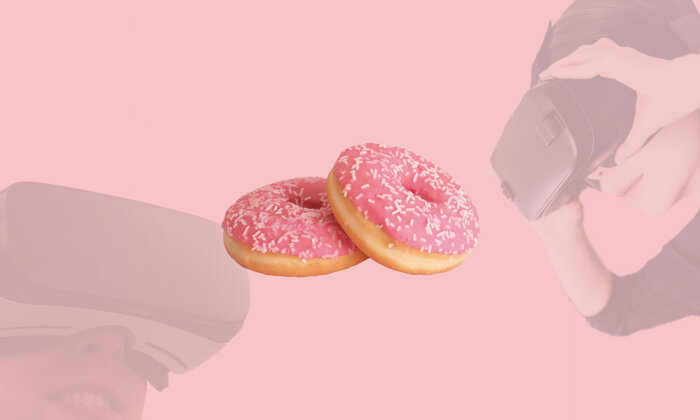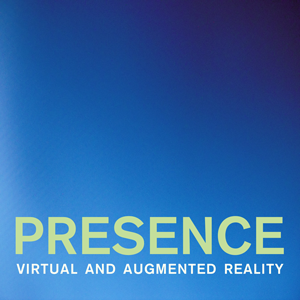Can Virtual Reality Make Us Healthier?

Imagine that very healthy or ethical food smelled and tasted just like food that we love but which might not be as healthy or sustainable — that the experience of eating a plant-based patty was like enjoying the best hamburger you’ve ever had. The possibility that the subjective experience of taste could be significantly impacted by a virtual experience has vast implications for the environment and the food industry.

In this episode of the MIT Press podcast, podcaster Chris Gondek talks to Jeremy Bailenson, Founding Director of the Virtual Human Interaction Lab at Stanford University and author of the book “Experience on Demand,” about a recent study in which Bailenson sought to determine whether touching and smelling donuts in a virtual reality setting contributed to eating less and feeling fuller. Bailenson also discusses the benefits and caveats of standalone consumer VR; the ethical implications of VR; reality-blurring (when a virtual memory gets mistaken for a physical one); and much more.
A stream and transcript of the podcast, which was originally recorded in 2018, can be found below.
Chris Gondek: Hello and welcome to the MIT Press podcast. I’m your host Chris Gondek and today I’m speaking with Jeremy Bailenson, the co-author, along with Benjamin Lee, of “Exploring the Influence of Haptic and Olfactory Cues of a Virtual Donut on Satiation and Eating Behavior,” which is to be published in the summer 2018 edition of Presence Teleoperators and Virtual Environments. Presence is the longest established academic journal that is devoted to research into teleoperation and virtual environments. Jeremy Bailenson is professor of communication at Stanford University and founding director of the Virtual Human Interaction Lab. His writings have appeared in the Washington Post, Slate and the San Francisco Chronicle. He’s the author of “Experience on Demand: What Virtual Reality Is, How It Works and What It Can Do.” Stay tuned after the interview for more information about the show. Jeremy Bailenson, thanks for being on the MIT Press podcast today.
Jeremy Bailenson: I’m thrilled to be here. Thanks for having me.
C.G.: Now we’re here to talk about the paper you co-authored with Benjamin Lee on whether sensory effects in the virtual world can alter consumption patterns in the real world, but your personal area of study is broader than that. How would you describe to someone what it is you do?
J.B.: My PhD is in cognitive psychology and for the last just about 20 years, what I’ve been doing with my colleagues is build VR. But more importantly, test a way that a virtual experience changes the way you think, the way you behave about yourself, about others, by giving you an experience. An experience that you couldn’t have otherwise, or perhaps it might be dangerous or impossible to do without VR. How does that virtual experience change the way you behave later on in the world? Whether that’s a health behavior or about empathy towards others or about how you can learn. My research focuses on how virtual experiences change real behaviors.
C.G.: This article, as I mentioned, focuses on smell and touch and how they can alter how people approach, in this case, a chocolate donut in the real world. Given that current VR technology only focuses really on hearing and sight, how were you able to design this study?
J.B.: Well, our job is to come up with a way to test the psychology of hardware, even if that hardware doesn’t exist yet. In this instance, the big idea behind the study was — let’s go away from donuts for a second. Imagine that really healthy food tasted and smelled and looked like unhealthy food. In other words, a lot of us, we like to eat food that may not be so good for us. Imagine that food that was healthy actually, we had the experience of food that we love that may not be as healthy. And so another way of saying it is imagine that a vegan patty tasted like the best hamburger that you’d ever had in your life, we’ve just solved climate change in terms of cutting down for us to allow for cattle. We have solved the obesity epidemic in the United States.
“A world in which we can eat healthy food and experience it as if it were the food we love, actually has epically large health benefits and benefits to the planet.”
A world in which we can eat healthy food and experience it as if it were the food we love, actually has epically large health benefits and benefits to the planet. In our study to do active haptics where you have machines can make you feel as if there are different shapes dynamically, that’s really hard to do. And scent objects in VR, olfactory VR, it’s not as hard to do to build the fence, but it is hard to integrate that with all the other VR. And so in this study we chose to go with what we call passive haptics, which is simply a fancy word for a plastic donut that we put in your hand. And for a scent, instead of an electronic and mechanical system, we just simply dipped a Q-tip inside of donut scent and found a way to regulate the amount of sense that it got it and actually attached to that Q-tip to the head-mounted display.
And in the study, everybody looked down and the first person saw their avatar and everybody looked down and they could move their physical hands. And their avatar’s arm would move with them in the first person, everybody saw a donut in their hand and they were instructed to bring it up to their face. Look at it a number of times. Half the subjects felt the donut and the way we did that is we put a plastic donut in their hand while half the subjects did not feel that plastic donut. And half the subjects smelled the donut by having that Q-tip dipped and donuts scent while the other half did not. And what we are doing in this study, we were trying to understand any good chef will know that presentation matters for taste, how something looks, how it smells, how it feels, the texture all contribute to the eating experience.
“In this study we chose to go with what we call passive haptics, which is simply a fancy word for a plastic donut that we put in your hand.”
In this study, we wanted to see what’s the effect of feeling a donut in your hand and smelling a donut on later consumption patterns. And this is a preliminary study. It was the first time we’d ever done something like this, not much prior work to go on. We had two competing hypotheses. One was satiation, which is that this experience, a virtual experience of smelling and touching this donut would be real enough such that you wouldn’t want to eat later on, you would feel satiated. The second one was priming, which is that you’re going to get reminded of how great donuts are by smelling it and feeling it and you’re going to want to eat more. And to be very clear, we didn’t go in with one prediction or the other. This was an exploratory study. We had a decent sample size. There were 101 subjects in the study, but we didn’t know which way it was going to go.
C.G.: What were the findings?
J.B.: The findings were, and again, preliminary but consistent in terms of after the study, subjects had the opportunity to eat some donuts. They took the goggles off and they said, “You finished this part and now here’s some donuts. We’re actually doing a taste test so you can write down your comments.” And we measured the weight of the amount of donuts that they ate. And what we found was support for satiation. People who felt the donuts in their hand ate fewer grams of donuts compared to those that didn’t feel it. And those that smelled the donuts also ate fewer grams of donut compared to those that didn’t smell it. Across both those conditions, people ate fewer donuts.
In addition, people reported feeling more full. We tended to trust self report less than behavioral data in studies like this, but people actually rated themselves as feeling fuller after they touched the donut compared to not and after they smelled the donut compared to not. We have two nice findings, one behavioral and one self report that indicate that this feeling and smelling of donuts contributed to eating less and feeling more full.
C.G.: I guess is there a next step as far as like, are you going to continue this line of inquiry or are you putting it out there for others to say, “Okay, here’s what we found. Go forth and see what else you can find.”
J.B.: Yeah, whether it’s from us or other labs, what I want to see is many, many replications. I’m trying to be very careful and qualify that we have not solved climate change and the obesity epidemic. We’re currently doing some ongoing replications. I would love to see other groups get on this research paradigm as well. We’re always happy to share our experimental content if teams want to use our stimuli to run their own studies, we’re happy to share that. And we want to see more replications, more understanding of the mechanism. I think that taste using VR scent, touch, and sight to alter the subjective experience of taste is going to be a very large, not just academic project, but application to those in the food industry. And I just want to see others engage. I think that’d be fantastic.
“We want to see more replications, more understanding of the mechanism. I think that taste using VR scent, touch, and sight to alter the subjective experience of taste is going to be a very large, not just academic project, but application to those in the food industry.”
C.G.: Now that takes care of this particular report, but you have a book out right now that talks about broader VR issues. And I was wondering if I could ask you some questions about I guess, virtual reality and kind of a larger issue in society.
J.B.: Yes, please.
C.G.: Let’s start with Oculus Rift. We recorded this interview May 11th, 2018. I read a pretty glowing review of Oculus Rift in the Washington Post a few weeks ago and they focused on the fact that the reviewer thought it was a good product, but what was really impressive for that person was is the cost is low enough that it could start bringing more mainstream consumers into the VR world. I guess would you agree with that conclusion?
J.B.: Most companies in the VR space right now, and there’s five to 10 of them, depending on how broad you talk about these global large tech companies, everybody is moving towards what the field is calling standalone products. You don’t need to have a fancy computer. The rendering and the tracking is done right from the goggles themselves. You’re in the one to 200 range as opposed to the five to 600 range. Across many of these companies you’re seeing a push towards this what the field was calling standalone VR. And I believe that the hardware is being quite well received by those that view it. The one caveat to that is that, for people that have been studying VR quite for quite some time, VR is not like pizza. With pizza even bad pizza is good. Bad VR is not good and you can get dizzy and you can get turned off from the technology fairly quickly.
“VR is not like pizza. With pizza even bad pizza is good. Bad VR is not good and you can get dizzy and you can get turned off from the technology fairly quickly.”
Even though we’re going for cheaper and not needing a dedicated PC to run it, I do urge caution in that, when VR is done well and the tracking is calibrated properly and you can render these scenes at the right frame rate, it feels good. And it’s an amazing experience. The book is called “Experience on Demand” because when VR is done right, we treat it as an actual experience or similar to an actual experience. And I love the push for a cheaper and standalone, however, I don’t want to lose sight of the fact that the high-end systems really produced the best experiences.
And there’s another trend in addition to the standalone, which you mentioned, Chris, there’s a trend for a what’s called location-based VR, which is a fancy word for — I grew up in the 1980s for the arcade model, going to an arcade and playing these games and location-based VR there is, the tracking is incredible and they’re putting in touch and fans and heat and passive haptics like strings hanging from the ceilings that can mimic cobwebs when you walk through them. And I do like that high-end model for the arcade and I think the simultaneous push from industry, which is let’s have cheap consumer VR, stand-alone for people to use by themselves, but what’s also maintained, this incredible high-end VR in locations. I like that dual approach.
C.G.: Now you’re a scientist and a scholar. You are not in the political world but I can’t help but — I was reading Google’s press release couple days ago about Duplex, their AI voice recognition software, which is just amazing. I heard that, I heard the calls that they put out as examples and it’s almost uncanny to the degree that it’s very hard to tell if it’s a human. It almost passes the Turing test. It’s hard to tell is it a human or is it a computer? Now again, this is not necessarily your bailiwick, but along with that demonstration, beginning to see articles about, well what is this like if all of a sudden you have agents that you can’t really tell if they’re real or they’re human making content for you? Should these agents be allowed to, I guess say ahead of time that I am not a human person. I’m an AI assistant working this for you. Taking this over to VR, are you concerned about, I guess as VR gets better, what some of the political or societal pushback might be on I guess analogous situation to what might run into with Duplex?
J.B.: One of the things we research in the lab is reality blurring and, for example, in the book, in chapter two, we talk about a lot of the work that we’ve done with children and adults about when a virtual memory gets mistaken for a physical one. And there is data that certain virtual experiences, especially with younger children, can become false memories. And I certainly, I often advocate for VR in a very particular way, which is not more than 20 minutes at a time, maybe a couple of times a week. I don’t see VR as a let’s read our email in here for eight hours a day type thing.
“There is data that certain virtual experiences, especially with younger children, can become false memories.”
And your point that as the scenes and these characters become better graphics, more degrees of freedom’s tracked if it’s a real time virtual human and more and more compelling, how the human brain can differentiate these virtual experiences and physical ones is one that we have to watch. I liked your idea of maybe watchdog organizations kind of reminding us when these things are real or when not. In the short term I will just remind our listeners that a little bit of VR is often enough and make sure you get outside and touch a wall, drink some water, talk to a person. These are all good things to do.
C.G.: You’ve said earlier that you were raised in the 80s, I was raised in the 70s so I was a teenager when the games were coming out, in a video arcade. In your research, when you start looking at people, your generation, my generation versus digital natives, the younger people who really, this is what they grew up, who did not know a world without internet, do you find differences to how I guess generations approach VR? Whether it’s just like, well for a digital native, somebody who’s never known anything but the internet, maybe there’s less of an issue with working with VR where you still have some people, I don’t want to say old farts like you and I, but people who have life experiences where there wasn’t internet, where still there’s a little bit of hesitation getting involved with that world.
“I will just remind our listeners that a little bit of VR is often enough and make sure you get outside and touch a wall, drink some water, talk to a person. These are all good things to do.”
J.B.: Well, so the idea of individual differences, whether it be age or where you’re from, country, all sorts of demographic issues. At MIT Press, we’ve got the journal Presence. Presence is the landmark journal that all of us are excited to publish in. And I’m an editor at Presence and it’s really, it’s been where we look for the most relevant and central research to the field of VR for decades. And what’s missing from the field of VR up until very recently, are large scale studies. In other words, to answer your question, which is, Is there a generational difference in terms of how VR is received in terms of presence and philosophies of how long is too long, et cetera? In order to do that, we’ve got to have a study where you’ve got hundreds if not thousands of people going through VR to get large enough samples to compare demographic differences.
And up until recently, VR has been extremely expensive and not portable and hard to build. And one study that we talk about in the book in chapter three on our empathy research is about one of my PhD students, Fernanda Herrera has accumulated a very large data set. She’s now run north of 2,000 subjects. And for this study she’s going out into the world. She goes to senior citizens homes, to flea markets, to museums, to schools. And what she is looking at is a very large sample that’s not just college students, to try to understand how do virtual experiences affect people who are not 19 years old, whether they’re younger or older, different socioeconomic status, different races. And in this study we are about to publish the first, I think the first very large database of how does presence work with different types of people. And we will get a preliminary answer to your question about how do people of different ages respond to virtual reality though of course this is one that’s going to require good years of work.
C.G.: What is something that you think is important about virtual reality, say in the next 10 years that isn’t being covered enough by the press?
J.B.: Well in the next 10 years that isn’t being covered by the press. I guess from a technological standpoint, we think about light field display and light field capture where you’re beaming on the display side where light’s getting beamed directly onto your retinas. Thinking about what the world looks like there. From a societal standpoint, I would like to see more discussion of, what do we allow to occur in VR as a community? Forget regulations from the government, but what’s okay to do in VR on what’s not? Think about VR, all the research shows the brain tends to treat VR as real. What are the behaviors that we should think about not doing in VR, whether it’s extreme violence or whether it’s certain types of unethical activities? We know VR is different than other media in that the brain tends to read it as real. I’d love to see some discourse about what’s okay to do in VR?
C.G.: Is there a URL where people can go to learn about the work you’re doing?
J.B: The best place to learn about the work we’re doing is to follow us on Twitter @StanfordVR.
C.G.: Jeremy Bailenson, the coauthor along with Benjamin Lee of “Exploring the Influence of Haptic and Olfactory Cues of a Virtual Donut on Satiation to Eating Behavior,” coming out in the 2018 issue of Presence. Thank you so much for being on the MIT Press podcast today.
J.B.: Chris, it’s been fantastic. Thank you.



